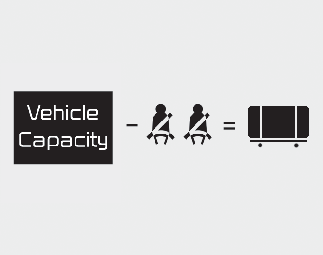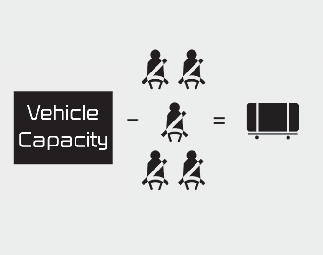Steps For Determining Correct Load Limit -

Loose cargo
Do not travel with unsecured blunt objects in the passenger compartment of your vehicle (e.g. suit cases or unsecured child seats). These items may strike an occupant during a sudden stop or crash.

|
Item |
Description |
Total |
|---|---|---|
|
A |
Vehicle Capacity Weight |
849 lbs. (385 kg) |
|
B |
Subtract Occupant Weight 150 lbs. (68 kg)×2 |
300 lbs. (136 kg) |
|
C |
Available Cargo and Luggage weight |
549 lbs. (249 kg) |

|
Item |
Description |
Total |
|---|---|---|
|
A |
Vehicle Capacity Weight |
849 lbs. (385 kg) |
|
B |
Subtract Occupant Weight 150 lbs. (68 kg)×5 |
750 lbs. (340 kg) |
|
C |
Available Cargo and Luggage weight |
99 lbs. (45 kg) |

|
Item |
Description |
Total |
|---|---|---|
|
A |
Vehicle Capacity Weight |
849 lbs. (385 kg) |
|
B |
Subtract Occupant Weight 161 lbs. (73 kg)×5 |
805 lbs. (365 kg) |
|
C |
Available Cargo and Luggage weight |
44 lbs. (20 kg) |
Refer to your vehicle's tire and loading information label for specific information about your vehicle's capacity weight and seating positions. The combined weight of the driver, passengers and cargo should never exceed your vehicle's capacity weight.